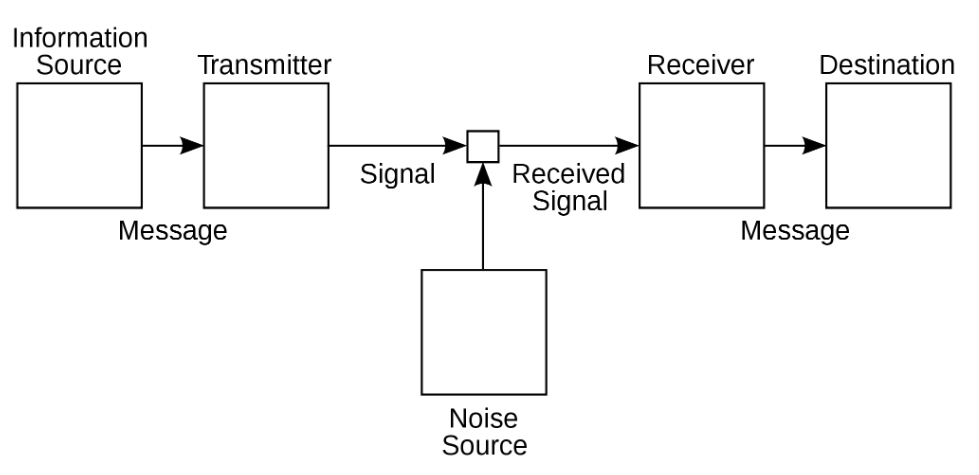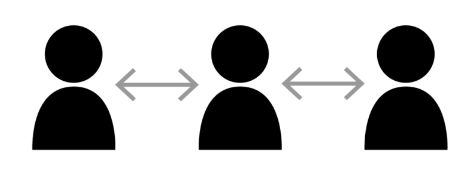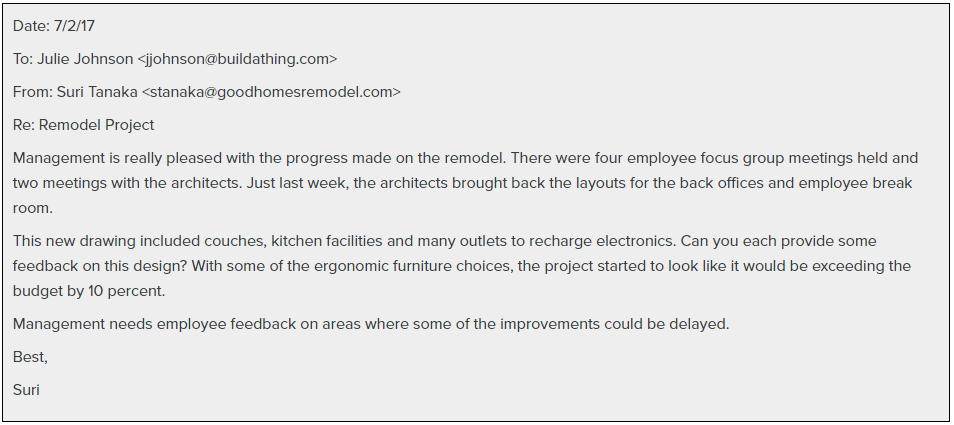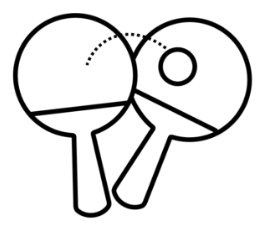2.2: Writing the Right Message
- Page ID
- 4100
What you’ll learn to do: Write a business communication given a specific audience and purpose
In business, being requested to write a business communication of some type can feel like “one more work assignment.” It is tempting to quickly jot and send that email or letter. However, by doing so, employees may miss the opportunity to help their company do more–and miss the opportunity for advancement. Crafting messages correctly is perhaps the single best way to polish your company’s and your own image.
Focusing the communication effort on the message’s receiver results in business objectives quickly achieved, and growing writer credibility. The results are subtle but the impact is large.
This section begins with two keys to success in business communication: audience and purpose.
watch it
The following video introduces a different business communication’s course, but the content is common to all courses.
Learning Outcomess
- Explain the importance of audience to business communication
- Discuss the importance of writing a clear and focused message in business
- Differentiate between types for writing positive, negative, and persuasive messages
Audience
The purpose of communication is to have the sender’s idea in mind reach the receiver’s mind with identical understanding.
Yet, communicating is not as simple and transparent as the image below suggests. Communication is surrounded by potential pitfalls and myriad opportunities for the main point to be lost or altered. Let’s take a look at Figure 1 to see a diagram of a communication system.

Figure 1: Shannon’s diagram of a general communication system.
Perhaps you are surprised to realize there is more than one audience for a message. There is the primary audience or receiver of the communication: this is the direct audience, who we’ll focus on in this module. In Module 6: Reports, we’ll also discuss indirect or remote audiences; these others include those who may see the communication even if they are not intended as a target of the communication. In this module, the direct audience is the focus. A good communicator is mindful of the other potential audiences when they start writing since doing so can help advance the company and advance a career.
The direct audience is the receiver of the business communication. This person or group of people might be internal or external to the sender’s organization. The relationship to the organization may impact the formality of the wording and the candor of the message. When new to business writing, be sure to check the tone with appropriate staff.
Practice Question
The store manager asked James to track down the paperwork on a missing shipment and write the email to Surfine Vending explaining what went wrong. James feels like he needs to do something more before he starts the message. He is right; which of the following does he need before he can start writing?
- more information about the receiver of the message
- the number of hours he searched to prove he did a good job
- a copy of the contract providing his company does not owe
- Answer
-
more information about the receiver of the message
Tone varies based on the power relationship of the sender to the receiver. The audience may be in one of three power positions relative to the sender summarized by the labels upward, downward, or horizontal communication.
Downward and Upward Communication
Downward communication flows from the managerial and executive levels to the staff through formal channels such as policy manuals, rules and regulations and organizational charts. Upward communication is initiated by staff and directed at executives; it frequently takes the form of a complaint or a request. Horizontal communication occurs when colleagues meet to discuss issues of common interest, resolve problems and share information.

Figure 2: Upwards and downwards communication
Horizontal Communication
When the flow of information is from peers in an organizational level to one or more of similar rank it is called horizontal communication.

Figure 3: Horizontal communication
This form of communication helps employees express information and ideas as well as coordinating the organization’s work.
talking across different levels
| Direction and purpose | You should say . . . | You should say . . . | Why? |
| Upward communication: an employee emailing the boss to request a day off | “Mr Sanchez, may I have Friday off?” | “Mr Sanchez, I’m going to take Friday off. Ok?“ | Deferential (formal title) and request rather than statement or demand |
| Downward communication: a manager emailing his work team to let them know he is off on Friday. | “Team, I’m out of the office Friday. Please hold any issues until Monday.” | “Team, do you mind if I take Friday off?” | Tone of authority not permissive. |
| Horizontal communication: an employee letting co-workers know about an upcoming vacation day. | “Hi all. I’ll be out on Friday. Can you handle anything that comes in or take a message for Monday?” | “I won’t be in tomorrow.” | Tone is peer to peer compared to the other samples. Be sure to include any information about potential coverage your peers may need to complete while you’re gone. |
Notice in each of the three sample messages that even in their few words, knowing the upward, downward or horizontal position of the receiver impacted the tone and phrasing of the message.
The Right Message
Most have heard the phrase “everything but the kitchen sink” which describes a situation in which almost nothing is left out. This phrase can easily be used when the intended communication has included far too much information. We live in a fast-paced world, so getting to the point is a valued time-saver. Having someone explain how to build a watch on the way to answering the question, “What time is it?” clearly demonstrates a speaker who has lost track of the primary purpose of the communication.
Here is an all-too-common example of the irritation and time that is lost in business communications when a purpose is not established.

Judging from the first sentence of the message, this email is a report on the status of the remodel. It is easy to set this message aside if it is a busy day (or week!). Looking more closely, it becomes apparent this is not a status message, but a request for input. When creating business message the writer must narrow the communication and organize the communication to highlight the primary purpose. Let the receiver know what is expected of the him or her early in the message.
You may be asking, “What does purpose of a business communication mean?” The answer is that the primary purpose of every business communication is to deliver information clearly and efficiently. Clear communication ensures the receiver understands the intended message. Efficient communication ensures the message is communicated quickly without a lot of ping-ponging back and forth. For example, imagine someone sends out a message about the team meeting next week on Tuesday in the main conference room but forgets the time of the meeting. A flurry of messages then fly back and forth, filling everyone’s inboxes.
In a less obvious manner, this ping-pong of communications comes when the initial message invites a response but does not show consideration of the user because it omits needed background. “Management decided to hold the company picnic on Tuesday May 13 at the Southside park. Please bring….” This message generates a flurry of emails about “Who will be the back-up staying in the office?” and “What happens in case of rain?” It is likely the sender has the answers to all these questions but did not think about how the receiver(s) might need to know this as well.

In order to avoiding the ping-pong of communication you must ensure these two things:
- The sender’s idea is clearly received by the audience
- The communication provides just what the receiver needs to know: not too much and not too little
Practice Question
Charon recently sent out an email to her coworker Ross inquiring when he might be finished with the first stage of a project. However, when she received his response, his email was filled with questions rather than an answer to Charon’s inquiry. After several exchanges, Ross was finally able to answer Charon’s initial question. If Charon were to look back at her initial email, what might she find?
- Her email included the right details, but it was too long, so Ross didn't read it
- Her email never made it to Ross's inbox
- Her email failed to include all of the information Ross needed to effectively answer her initial question
- Answer
-
Her email failed to include all of the information Ross needed to effectively answer her initial question
Positive, Negative, and Persuasive Messages
All business messages fit across to two broad categories with an overlapping third category. There are communications where the receiver is expected to have a positive or neutral reaction, and there are communications about which receivers may have a more negative reaction. The image of the continuum below is focused on audience reaction to a message.

We’ll discuss exactly how to write these messages later in this module when we discuss the three-part writing process. For now we’ll focus on how to determine which type of message fits your audience.
Positive Messages
Positive messages include messages where the audience is expected to react in a neutral to positive manner. Positive messages tend to consist of routine or good news. These messages might be items such as congratulations, confirmations, directions, simple credit requests, or credit approvals. Also included in this category might be denials that are somewhat routine or expected. This could be something like a parking lot closure that inconveniences employees, but in a minor way. As strange as this sounds, sympathy messages are in this category as well. Sympathy messages are routine since they will not be a surprise to the receiver.
Consider the message to be a positive message structure when:
- The receiver likes or expects this news (product shipped on time)
- The receiver needs little education or background to understand the news (travel arrangement for the conference)
- The receiver considers the message routine, even if not completely positive (parking lot closed for three days for new striping)
Negative Messages
Negative messages include messages where the audience is expected to react in a negative manner. Negative messages consist of bad news. In these messages, the sender’s goal is to convey the bad news in a manner that preserves the business relationship. While the sender must deliver bad news, the sender wants to avoid an employee quitting or a customer finding another vendor. These messages might be items such as refusal to provide a refund, cancellation of an event, inability to support an event and more.
Consider the message to be a negative communication when:
- The receiver may be displeased (cost for repair is the receiver’s, not the utility company’s)
- The receiver needs a little persuasion (new log-on procedure takes longer but is more secure)
- The receiver may be somewhat uncomfortable (new badging system underway because employees have been sharing badges)
Persuasive Messages
The third, overlapping category is persuasive messages. With this category, the audience is expected to need encouragement in order to act as the sender desires. In some cases, the receiver is more like a positive audience; for example, when you’re asking for a recommendation letter or when you’re inviting someone to attend an after-hours work function. In other cases, the receiver is more like a negative audience; for example, when you’re requesting additional payment as a result of a shared error or when you’re providing an extension to an impending due date.
Consider the message a persuasive communication when:
- The receiver may be reluctant (please speak to the new employee group)
- The receiver is being asked a favor (please write recommendation letter)
- The receiver may be invited to something somewhat outside regular duties (please supervise a new book club that will meet on campus after work)
Practice Questions
James’s manager asked him to email the rest of the employee team to let them know about the new security badging system and the security cameras being installed. James is worried the employees will think the company is being intrusive in a spying sort of way. What should James do next?
- Plan his message around a negative audience
- Write the message assuming a neutral audience
- Ask two or three employees if they think this system seems like managerial spying
- Answer
-
Plan his message around a negative audience
Practice Question
Katerina was recently put in charge of the company payroll charity deduction effort. She is so excited to be recognized by management for this special effort, and she knows she will have special release time for the next three months. Quietly, she thinks to herself about how she used to groan each year as others have asked her to sign up for these payroll deductions. She knows this is a very good cause, but her co-workers will feel the way she used to: “ugh, one more deduction to the weekly paycheck.” As she gets ready to put out the first background email about what the charity does and how the company supports it, she wonders if she should use a positive message outline or a negative message outline.
- The email is likely to be received as a negative message by her co-owners
- This is an informational email, so she can just put a paragraph on the front of the charity's brochure
- The email is likely to be received as a positive message by her co-owners
- Answer
-
The email is likely to be received as a negative message by her co-owners

